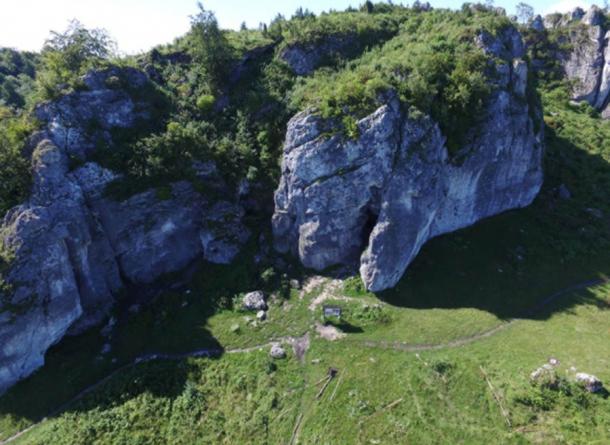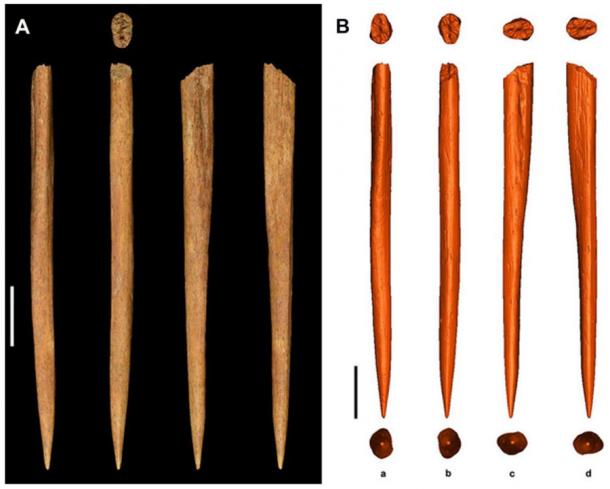A skillfully decorated mammoth ivory pendant found in Stajnia Cave in southern Poland in 2010 has been radiocarbon dated to approximately 40,000 BC, as is detailed in a new study published in the journal Scientific Reports . The ornate ivory pendant, which was decorated with a curved series of carefully placed puncture marks, it is the oldest example of decorative jewelry ever found in Eurasia.

Aerial view of Poland’s Stajnia Cave where the Upper Paleolithic mammoth ivory pendant was discovered in 2010. (© Marcin Żarski / Nature)
Ivory Pendant Found In Cave Also Used By Neanderthals
The two pieces of carved ivory that formed the pendant were originally recovered during excavations at Stajnia Cave in 2010. The cave was occupied first by Neanderthals in the far distant past , and later by modern humans in the early part of the Upper Paleolithic Age (starting around 50,000 years ago).
Because of disruptions caused by frost and other natural phenomena, it was impossible to date the artifact based on its location in a particular stratigraphic layer. This left radiocarbon dating as the only method for accurately dating the pendant.
An international team of experts led by chemistry professor Sahra Talamo from the University of Bologna in Italy were tasked to perform these tests, along with other procedures that would reveal more details about the characteristics of the pendant. An awl (puncturing tool) made from the leg bone of a horse was also subjected to the same tests, as this tool had been found in the same excavation layer as the two halves of the broken mammoth ivory pendant.
To facilitate radiocarbon testing, collagen was extracted from the pendant and awl at the Max Planck Institute for Evolutionary Anthropology in Leipzig, Germany. Two radiocarbon dating tests were carried out for each item at two separate laboratories, using an accelerator mass spectrometer to guarantee the most precise results.
These definitive tests showed that the ivory pendant had been made sometime between 41,730 and 41,340 years ago, while the bone awl had been carved sometime between 42,270 and 42,070 years ago.
This confirmed that the pendant was the oldest example of this type of jewelry ever found at an archaeological site in Eurasia. Other pendants of this type had previously been found in Geißenklösterle Cave in Germany and Tuto de Camalhot Cave in France, but stratigraphic layer analysis showed those items had been produced between 30,000 and 40,000 years ago.

The Stajnia mammoth ivory pendant and the location of the site in Poland. (A) Site location in southern Poland ( CC BY-SA 4.0 ) and aerial picture of Stajnia Cave; (B) Dorsal and ventral views of the pendant (S23100, S22222). Scale bar is 1 cm. (C) Schematic representation of the pendant (dorsal view). Numbers 1 to 50 indicate clearly identifiable punctuations; dotted lines indicate possible punctuations. The red hatch indicates the exfoliated area. The scale bar is 1 cm (0.4 inches). ( Nature)
Marks on the Ivory Pendant had Some Utilitarian Purpose
When the two sections of the mammoth ivory pendant were put back together, they formed a piece of jewelry that was approximately two inches (4.5 centimeters) long and about one inch (2.5 centimeters) wide. The pendant was oval-shaped and smoothed around the edges and included two holes for adding a string. There were approximately 50 shallow puncture marks visible on one side of the pendant, which formed a looping curve that bisected the pendant’s body.
The scientists involved in this study think it is unlikely these puncture marks were placed there strictly as decorations. They believe they had some sort of utilitarian purpose, possibly recording the number of animals killed by a hunter or somehow reflecting the location of the sun or moon as they moved through the sky.
Regardless of what the marks on the pendant’s surface mean, the pendant itself is still recognized as a form of decorative art, specifically made to be worn and displayed. Its shape was likely chosen either because the maker thought it looked attractive, or because the wearer wanted something customized that would advertise their unique identity.

The Stajnia awl, made from a horse bone, was also found in the Polish cave where the ivory pendant was discovered. (A) Original picture of the awl from Stajnia Cave; (B) Reconstructed 3D digital models of the awl. Scale bars are 1 cm (0.4 inches). ( Nature)
Aurignacian Culture and the Rise of Homo Sapiens in Eurasia
The ivory pendant and awl found in Stajnia Cave were produced by people from an early modern human culture known as Aurignacian.
The term Aurignacian refers to a style of toolmaking that first appears in the European archaeological record around 43,000 years ago. It was developed and introduced by modern humans, following their migrations into the area.
Aurignacian culture remained in existence until about 26,000 years ago. Its technological reign largely coincided with the replacement of the Neanderthals by modern humans in Western Eurasia.
The people of the Aurignacian culture produced a great diversity of tools. They frequently worked with bones, antlers, and ivory, using flint blades to shape, decorate, or otherwise customize their tools and other objects for a variety of purposes.
In addition to making tools, they also produced quite a bit of jewelry, including bracelets, beads, and pendants. They were artistically inclined in general, which is reflected in their cave art and in their production of three-dimensional figurines of animals and stylized figures of Venus (their version of the goddess of fertility). They also engraved and shaped their jewelry to make a stronger artistic impression.
The Aurignacian culture was foundational, setting standards for excellence and expression that the ancestors of the first modern humans in Eurasia would be destined to follow. Its development signaled the true arrival of modern humans on the scene, as they pushed the long-dominant Neanderthals to the margins where they were ultimately doomed to go extinct .

The famous Venus of Willendorf dates from the late Aurignacian period but the Polish cave mammoth ivory pendant is a much older piece of Aurignacian decorative art. (MatthiasKabel / CC BY-SA 3.0 )
Artistic Imagination and Human Consciousness Evolution
The scientists involved in this study acknowledge their primary goal is to learn more about what the earliest humans to arrive in Eurasia were really like. In their Scientific Reports paper, they write about “the importance of directly dating mobiliary art to solve the intriguing puzzle of the emergence of symbolic behavior and modern cognition in human evolution.”
The development of an artistic imagination is certainly one marker that reveals how ancient humans saw themselves and related to each other and the world around them. Art of all types is designed to make an impression on others, which demonstrates that humans who lived in the Upper Paleolithic in the Western Eurasian region had developed a notable level of social consciousness and self-awareness.
By examining and interpreting the style and content of Upper Paleolithic art , in its mobile and cave wall forms, anthropologists and archaeologists can explore the fascinating question of how ancient people were similar to us, and how they were different.
Top image: Dorsal and ventral views of the mammoth ivory pendant discovered in Stajnia Cave in southern Poland in 2010. Scale bar is 1 cm (0.4 inches). Source: © Antonino Vazzana – BONES Lab / Nature
By Nathan Falde
Related posts:
Views: 0
 RSS Feed
RSS Feed

















 November 26th, 2021
November 26th, 2021  Awake Goy
Awake Goy  Posted in
Posted in  Tags:
Tags: 
















